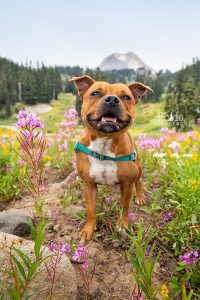April is Canine Fitness Month. Ramp up your dog’s routine with these great ideas from the OHS Training & Behavior team.

Walks, runs, swims and play time with you can help your dog stay healthy and could prevent boredom-based behavior issues. Along with physical activity, be sure to add mental exercise to your pup’s routine. Dogs love to use their brains and all of that thinking can help them burn off extra energy.
Here are eight ideas to help you think outside of the walk. Remember to consult with your veterinarian before starting a new activity.
- Go for a run. Running with your dog is a great way to spend time together while staying in shape. If your dog has been a couch potato all winter, it’s important to take things slowly. Going for a five mile run when your dog is used to a walk around the block could lead to injury. Before you try running, make sure your dog can walk nicely on a loose leash. Ideally, you want your dog to stay by your side during your run, not pull ahead of you or roam from side to side. When you’re ready to go for that first run, use the right equipment. A regular 4 to 6 ft. leash and a comfortable, well-fit harness work best. Have your dog wear reflective gear if running at night.
- Enjoy a mindful stroll. Instead of walking for distance or on a set route, leash up your dog and set a timer. For thirty minutes, allow your dog to spend however long he wants sniffing a particular tree and have him choose which direction he wants to walk. If he stops to roll in the grass – let him! You may not get very far, but your dog will be happy and tired after using his nose to its fullest potential.
- Encourage your dog to play with toys. Avoid wrestling with your dog, which can overexcite him and teach him to play roughly. Instead, teach your dog to “fetch!” To make a toy come alive, squeak it, toss it away from your dog and ask him to “get your toy!” Praise him for picking up a toy and bringing it back to you. Ask him to “sit” before throwing it again. If he’s struggling to drop the toy, try adding a second one to this mix. Ideally, he will drop the first toy to run after the second. Rotate your dog’s toys if they seem to get bored easily with the same item.
- If you have mobility issues or a small yard, using a ‘chase-and-pull’ toy can help your dog burn off energy without tiring you out. These types of toys have a long wand that you hold and lightweight toy tied to the end, like a large cat’s feather toy. You make the fun by moving the toy around along the ground so your dog can chase it. After a few attempts, allow your dog to catch the toy. Encourage him to “drop it” and as soon as he does, praise him and start the game again!
- Take a sports or exercise class with your dog. You and your dog might enjoy agility, flyball, treibball, dock diving, nosework, or doggie yoga! Not sure where to begin? Try our Sports and Shenanigans Sampler class to get a taste of different activities you can do with your dog.
- Practicing basic cues and learning new tricks can be a fantastic way to tire your dog out on a rainy evening or a hot summer day. Take a class with your dog or check out online videos for inspiration. Look for trainers that use positive reinforcement and reward-based training methods.
- Instead of feeding your dog from a bowl, put his kibble in a puzzle toy. Dogs who have never played with puzzle toys may not understand how they work. To avoid frustration, start easy and take time to show your dog how to solve the puzzle.
- Play scent games: Grab two or three small, cardboard boxes that differ in size (shoe boxes work great!) and put a treat into each one. Encourage your dog to use his nose to search for the treats. Leave the boxes open or loosely covered at first and slowly make it more challenging. You can also just hide treats or his kibble around the house and teach him to “find it!”
Adding more physical and mental exercise to your dog’s life could prevent them from finding their own entertainment – like chewing on your shoes or barking for attention. Whatever new activities you try, pick ones that both you and your dog will enjoy. Don’t force your dog to do something that is scary to them or too physically challenging.
 Tanya Roberts is the Senior Manager of the OHS Training & Behavior Department and a Certified Professional Dog Trainer (CPDT-KA). Tanya continues her education by attending seminars and trainings so she can provide clients with current, scientifically based information. Her best teachers continue to be the wonderful animals at the Oregon Humane Society who she works with regularly during their stay.
Tanya Roberts is the Senior Manager of the OHS Training & Behavior Department and a Certified Professional Dog Trainer (CPDT-KA). Tanya continues her education by attending seminars and trainings so she can provide clients with current, scientifically based information. Her best teachers continue to be the wonderful animals at the Oregon Humane Society who she works with regularly during their stay.


